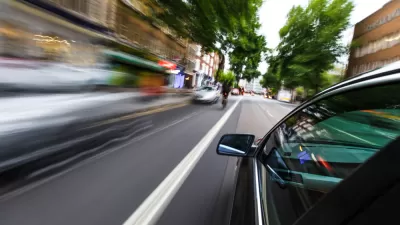Most personal vehicles can travel at speeds of over 100 miles per hour, far above any U.S. speed limit. Why?

Writing in Fast Company, David Zipper presents an argument for mandating speed-limiting technology on personal vehicles—an argument now being made by federal regulators.
Using an example from Las Vegas where a driver going more than three times the speed limit killed nine people, Zipper notes that an investigation summary from the National Transportation Safety Board (NTSB) of the crash “recommended that automakers install technology on all new cars that can prevent reckless speeding—and, for the first time, called on the National Highway Traffic Safety Administration to mandate it.”
For Zipper, “That is an excellent, overdue idea.” Speed governors are already mandated on much less deadly vehicles like e-scooters (and some company vehicles), and many modern cars do have speed limiters that cap speeds at 155 miles per hour. Why not set them at a more reasonable, less deadly limit?
The NTSB recommends that the National Highway Traffic Safety Administration (NHTSA) require the adoption of Intelligent Speed Assist (ISA) technology. As Zipper explains, “‘Passive’ ISAs issue audible or haptic alerts to drivers who exceed the top programmed speed, hopefully compelling them to slow down. ‘Active’ ISAs intervene in the car’s mechanics, often by requiring the driver to apply extra force on the accelerator.” The technology will be mandated on cars in Europe starting next year.
FULL STORY: You shouldn’t be driving over 100 mph—and your car shouldn’t let you

Planetizen Federal Action Tracker
A weekly monitor of how Trump’s orders and actions are impacting planners and planning in America.

Congressman Proposes Bill to Rename DC Metro “Trump Train”
The Make Autorail Great Again Act would withhold federal funding to the system until the Washington Metropolitan Area Transit Authority (WMATA), rebrands as the Washington Metropolitan Authority for Greater Access (WMAGA).

The Simple Legislative Tool Transforming Vacant Downtowns
In California, Michigan and Georgia, an easy win is bringing dollars — and delight — back to city centers.

The States Losing Rural Delivery Rooms at an Alarming Pace
In some states, as few as 9% of rural hospitals still deliver babies. As a result, rising pre-term births, no adequate pre-term care and harrowing close calls are a growing reality.

The Small South Asian Republic Going all in on EVs
Thanks to one simple policy change less than five years ago, 65% of new cars in this Himalayan country are now electric.

DC Backpedals on Bike Lane Protection, Swaps Barriers for Paint
Citing aesthetic concerns, the city is removing the concrete barriers and flexposts that once separated Arizona Avenue cyclists from motor vehicles.
Urban Design for Planners 1: Software Tools
This six-course series explores essential urban design concepts using open source software and equips planners with the tools they need to participate fully in the urban design process.
Planning for Universal Design
Learn the tools for implementing Universal Design in planning regulations.
Smith Gee Studio
City of Charlotte
City of Camden Redevelopment Agency
City of Astoria
Transportation Research & Education Center (TREC) at Portland State University
US High Speed Rail Association
City of Camden Redevelopment Agency
Municipality of Princeton (NJ)





























